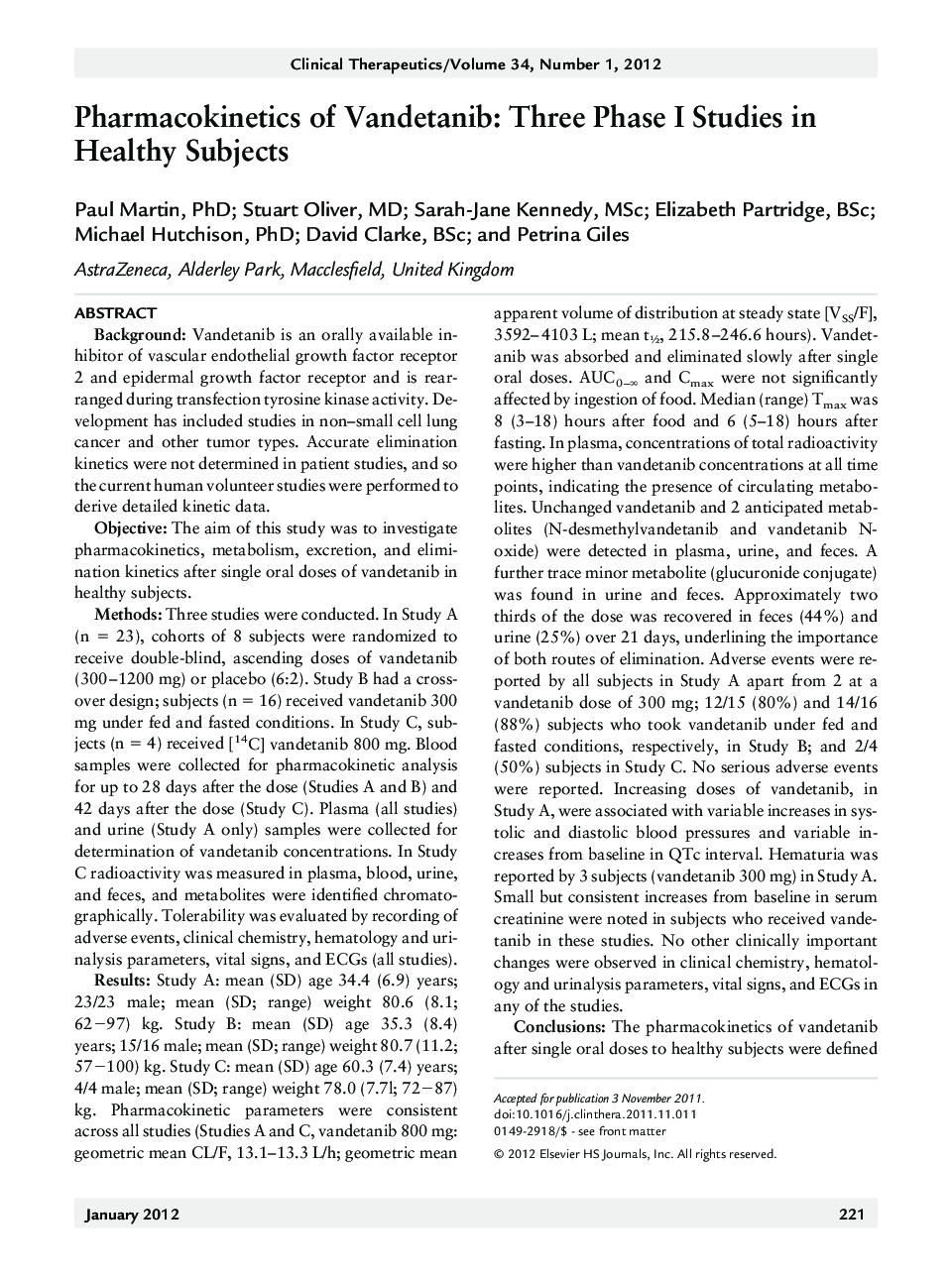| کد مقاله | کد نشریه | سال انتشار | مقاله انگلیسی | نسخه تمام متن |
|---|---|---|---|---|
| 2527384 | 1119912 | 2012 | 17 صفحه PDF | دانلود رایگان |

BackgroundVandetanib is an orally available inhibitor of vascular endothelial growth factor receptor 2 and epidermal growth factor receptor and is rearranged during transfection tyrosine kinase activity. Development has included studies in non–small cell lung cancer and other tumor types. Accurate elimination kinetics were not determined in patient studies, and so the current human volunteer studies were performed to derive detailed kinetic data.ObjectiveThe aim of this study was to investigate pharmacokinetics, metabolism, excretion, and elimination kinetics after single oral doses of vandetanib in healthy subjects.MethodsThree studies were conducted. In Study A (n = 23), cohorts of 8 subjects were randomized to receive double-blind, ascending doses of vandetanib (300–1200 mg) or placebo (6:2). Study B had a crossover design; subjects (n = 16) received vandetanib 300 mg under fed and fasted conditions. In Study C, subjects (n = 4) received [14C] vandetanib 800 mg. Blood samples were collected for pharmacokinetic analysis for up to 28 days after the dose (Studies A and B) and 42 days after the dose (Study C). Plasma (all studies) and urine (Study A only) samples were collected for determination of vandetanib concentrations. In Study C radioactivity was measured in plasma, blood, urine, and feces, and metabolites were identified chromatographically. Tolerability was evaluated by recording of adverse events, clinical chemistry, hematology and urinalysis parameters, vital signs, and ECGs (all studies).ResultsStudy A: mean (SD) age 34.4 (6.9) years; 23/23 male; mean (SD; range) weight 80.6 (8.1; 62−97) kg. Study B: mean (SD) age 35.3 (8.4) years; 15/16 male; mean (SD; range) weight 80.7 (11.2; 57−100) kg. Study C: mean (SD) age 60.3 (7.4) years; 4/4 male; mean (SD; range) weight 78.0 (7.7l; 72−87) kg. Pharmacokinetic parameters were consistent across all studies (Studies A and C, vandetanib 800 mg: geometric mean CL/F, 13.1–13.3 L/h; geometric mean apparent volume of distribution at steady state [VSS/F], 3592–4103 L; mean t½, 215.8–246.6 hours). Vandetanib was absorbed and eliminated slowly after single oral doses. AUC0–∞ and Cmax were not significantly affected by ingestion of food. Median (range) Tmax was 8 (3–18) hours after food and 6 (5–18) hours after fasting. In plasma, concentrations of total radioactivity were higher than vandetanib concentrations at all time points, indicating the presence of circulating metabolites. Unchanged vandetanib and 2 anticipated metabolites (N-desmethylvandetanib and vandetanib N-oxide) were detected in plasma, urine, and feces. A further trace minor metabolite (glucuronide conjugate) was found in urine and feces. Approximately two thirds of the dose was recovered in feces (44%) and urine (25%) over 21 days, underlining the importance of both routes of elimination. Adverse events were reported by all subjects in Study A apart from 2 at a vandetanib dose of 300 mg; 12/15 (80%) and 14/16 (88%) subjects who took vandetanib under fed and fasted conditions, respectively, in Study B; and 2/4 (50%) subjects in Study C. No serious adverse events were reported. Increasing doses of vandetanib, in Study A, were associated with variable increases in systolic and diastolic blood pressures and variable increases from baseline in QTc interval. Hematuria was reported by 3 subjects (vandetanib 300 mg) in Study A. Small but consistent increases from baseline in serum creatinine were noted in subjects who received vandetanib in these studies. No other clinically important changes were observed in clinical chemistry, hematology and urinalysis parameters, vital signs, and ECGs in any of the studies.ConclusionsThe pharmacokinetics of vandetanib after single oral doses to healthy subjects were defined and the metabolic pathway was proposed. Vandetanib was absorbed and eliminated slowly with a t½ of ∼10 days after single oral doses. The extent of absorption was not significantly affected by the presence of food. Approximately two thirds of the dose was recovered in feces (44%) and urine (25%) over 21 days. Unchanged vandetanib and N-desmethyl and N-oxide metabolites were detected in plasma, urine, and feces. Vandetanib appeared to be was well tolerated in the populations studied.
Journal: Clinical Therapeutics - Volume 34, Issue 1, January 2012, Pages 221–237